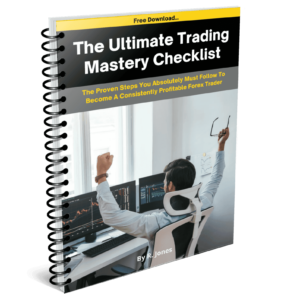“The Consistency You Seek is in Your Mind, Not in the Markets” Mark Douglas
If you’ve been involved in trading for even a short period of time, you’re probably aware that your psychology is one of the biggest and overriding factors to to consistent profits and success
You can spend all your time, energy and money learning to read charts, candlesticks, indicators, strategies etc, but your account still never grows.
It’s so frustrating. You feel angry and worthless and sometimes it could even send you into a spiral of depression
It can seem like you’ll never get where you want to go.
Before moving on, it’s important to stress that there are no shortcuts to mastering the trading psychology game.
All traders are human.
Even the 7 & 8 figure a year traders are vulnerable to psychological lapses leading to mistakes and losses.
But there are some effective ways that they adopt and you can copy to help you avoid these psychological traps.
I’ve been avidly searching articles and videos by some of the top experts in trading psychology. And I’ve found some pretty cool, but simple tips I want to share with you today.
Simple But Proven Brain Hacks To Completely Turn Around Your Trading
Adam Grimes is a Forex teacher, coach, and mentor and author of the best selling book The Art and Science of Technical Analysis who says:
“Work on pattern interrupts”
If you’re searching for a shortcut technique, this might be it.
A pattern interrupt is a way to recognize when you may be about to do something foolish or emotionally-driven, and interrupt the pattern . There are multiple ways this can be done, such as going for a walk, making a call, working out, or taking a few days off from trading.
First and foremost you must build an awareness of your mental and emotional state.
This is the absolute key.
Once you are able to do that you can then take the necessary steps to disrupt the negative cycle you’re currently in
Let’s say for instance you become really angry and frustrated after a series of losses and revert to emotional trading (Revenge Trading) as a way to make up the money you’ve lost.
These trades are impetuous and thoughtless and ordinarily results in you losing more and more money!!
Therefore it’s imperative you stop it in its tracks.
So to begin, you must have a plan and be aware of your emotional state to be able to recognize that you are feeling emotional and might be tempted to make a revenge trade.
Even though not making the trade may feel overwhelmingly difficult , being aware of your emotional state will be the trigger to you leaving your workstation, go outside, and thereby preventing trading impulsively
This technique will require some work on your part initially, but if you persevere your trading will reap the rewards.
Greg Secker is a trader, public speaker and owner of ‘Learn to Trade who says:
“Reframe The Concept Winning & Losing”
As well as preserving capital one of the other main reasons pro traders keep their risk low is so to remove the emotional significance of each and every trade.
Using a chess analogy he explains that as a trader you want to adopt the approach of every trade being pawns rather than queens.
By that he means, if you’re playing chess and your opponent takes one of your pawns, then it’s not as fatal as taking your queen because you’re still in with a chance of winning the overall game.
For the majority of new or inexperienced traders who are still developing their trading mindset, the negative connotations connected with winning and losing can impact their confidence and self worth.
So when risking just 1% or 2% on each individual trade professional traders don’t refer to them as winning or losing.
Rather, they can simply be referred to as trades that are either up or down, or ahead or behind.
This type of language has far less emotional impact, allowing traders to think much more clearly and analytically about their trading, and preventing any guilt or disappointment throwing you off course.
Alex Bustos, Full-time trader and founder of B the Story who says:
“Tally & Track Your Trades”
This technique is designed to help traders pull the ‘trigger’ on the next trade after a big loss or series of losses
It’s a technique he learned from Mark Douglas, the best selling author of ‘trading in the Zone’.
Douglas was a genius when it came to helping traders understand and think in probabilities and how to implement it within their trading.
He promotes how vital it is for traders to convince themselves that trading is simply a game of probability.
On a trade-by trade basis the outcome is completely random, but if you string together a large sample size of trades using your ‘edge’ then the profitable edge will eventually materialise.
This is just how it works for casinos
They play the long game, knowing they’ll eventually win… without fail.
So what this technique basically entails is to tally every time you have a signal and simply place the trade all the way up to 20 trades.
No ifs! No buts! No maybes! No Exceptions!
You take the trade regardless!
But here’s the trick…
You must dramatically reduce the position size you normally trade at.
Why?
Well just imagine for a minute you lost every single one of those 20 trades.
Whatever risk you have on each trade you have to times that by 20.
So for example, you usually risk £100 on each trade, times that by 20 and your total loss will be £2,000.
Are you comfortable losing that amount?
If that figure makes you feel nervous or hesitant then you must reduce your size to something that you’re comfortable losing.
For this exercise to work you need to completely remove all hesitancy.
So to recap- you’re going to dramatically reduce your position size (even if it’s risking only £1), and following your trade set up you’re going to pull the trigger every single time and do a tally up to 20.
Remember, this isn’t about how much money you’re making, it’s an exercise in helping you learn to keep pulling the ‘trigger’
Then after the conclusion of each trade, mark whether it was a WIN (W) or a LOSS (L)
Please don’t stress whether it’s a loss or a win, and whatever you do don’t stop trading because you have lost 3, 6 or 8 trades in a row.
The thing is, you decided at the outset what your risk tolerance level was if you lost 20 trades in a row, so you should be comfortable to keep taking the trades.
From experience here’s what you’ll find when you implement this approach…
You’ll start to realise how random your results are in practice, and that you’re simply trading in probabilities.
You could see yourself winning 4 trades in a row, then be hit with 5 consecutive losers, then have 5 winners followed by 2 losers.
Repeat this exercise the 2nd and 3rd time and you’ll begin to see even more clearly the randomness of your winners and losers.
Providing, of course you’re trading with an ‘edge’, and following your trading plan & rules, this exercise will help enormously with your nerve and confidence to live/trade through the losses and the sheer randomness of your results.
The thing to always remember, is when you trade in probabilities, the mathematical formula does not know the outcome of any given trade even when the deck is stacked in your favour…and neither do you!
So keep ‘PULLING THE TRIGGER’
Binomo- an online investing and trading platform says:
“Understand the power of Compounding”
I picked this final hack up from the guys at Binomo and I think it can certainly provide an advantageous mindset switch once you grasp and fully understand its power.
In basic terms, compound interest is when you reinvest your earnings, which then earn interest as well.
It essentially means ‘interest on the interest and is the primary reason why many investors such as Warren Buffet have become so successful.
The power of compound interest is unquestionable.
And as Albert Einstein once said…
“Compound interest is the eighth wonder of the world. He who understands it, earns it; he who doesn’t, pays it”
So when trading, rather than chasing trade after trade looking for ‘home runs’ every time, focus instead on making smaller consistent gains and allow compounding interest to take effect.
This approach is much less stressful and a lot more powerful.
Here’s a quick example of compound interest at work…
Let say, you set yourself a profit target of 5% a week or 1% a day i.e. Monday to Friday
After just one month you’d be up 24.5%. If you were trading a £1,000 account, it would have grown by £244.72 in one month.
What if you kept this level of compounding growth for a full year?
Assuming your account grew 1% every day (excluding weekends) for an whole year, it would then be worth £13,423.90 – a total percentage profit of 1242.4%
Pretty impressive you have to say, and just emphasises the power of compound interest.
Why not do your own daily/monthly or yearly compound interest calculations with this cool online calculator.
https://www.thecalculatorsite.com/finance/calculators/daily-compound-interest.php
Try these out this week and see what happens
As you can see, there are proven mind hacks and techniques used by the pros that can elevate and transform your trading to new levels
All you have to do implement them with your trading
Give one of these ideas a try this week, and let me know how you get on!


